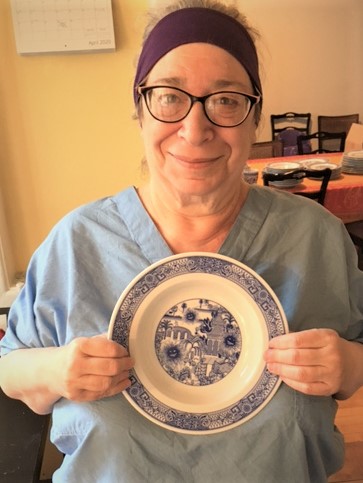Last week I worked at a vaccine clinic in Montreal. I volunteered as a vaccinator when the director of Professional Services of our hospital and the head of the regional health authority asked for help in the Quebec campaign to get the population vaccinated as quickly and efficiently as possible. I am supposed to be semi-retired, working two and a half days a week, but this week all my extra duties ganged up on me. I was swamped all week long, and on Monday, I suddenly realized that my usually free Friday was going to be spent explaining vaccine side effects and getting consent from hundreds of people.
So early Friday morning, my husband drove me to a large semi-abandoned mall. Walking in at quarter to eight, I signed in at the desk, got a key to the locker room, and gowned up. After a long detour through the IT desk to get computer access, I sat down with a gentle home care nurse as he guided me through my responsibilities and showed me how to use the program. I was an evaluator, asking screening questions and explaining possible side effects, getting informed consent.
By 8:20, the people started coming, one after another. Most of the ones early in the day were older, often accompanied by stressed and harried relatives. A very frail Punjabi couple accompanied by their grandson were among the first. I was so grateful that he was there, translating and helping them move along the multiple stations. There were people from every ethnic community in our area, one of the most multicultural in Montreal.
The room was a huge concrete box. The noise was deafening, and every sound bounced around the sterile space. It was hard to hear the patients sitting across the desk from us, between our masks and the echoes; I felt like I sometimes had to shout. Once the forms were filled, the patients went to the waiting nurses and medical students who hit them up with the vaccine, put a band-aid on and directed them to the chairs where they waited for their obligatory fifteen minutes.
Our vaccinating team was clicking now, laughing and joking, as we processed over 20 people an hour.
When I go for my break, I find a message from my husband. The government had announced that people over 65 could now get vaccinated. Two different friends called him, and he went directly to the website. He got an appointment for that afternoon just at the end of my shift. I almost cried; I was so relieved. Every day, I worry that I will bring the virus home with me from work. Now he would be protected from my high-risk practice.
I tried to make the vaccination encounter, as brief as it was, personal and upbeat. Many people were a bit hesitant, worried that the vaccine would be dangerous. I did my best to alleviate their fears, primarily by putting them into context. Others were celebrating this step to freedom, travelling, and most importantly, being with their families. I joked; I asked 70-year-old women if they were pregnant. I used my 3 words of Yiddish, Hebrew, Greek, Italian and Punjabi to try and connect. One elderly Vietnamese lady came in, impeccably dressed in a Chanel-style suit with a matching hat. It was hard to hear her soft voice above the din, and our French seemed to be mutually incompatible.
“Does anyone here speak Vietnamese?” I called out to one of the administrators as she walked by. One of the vaccinators came over, “My Vietnamese is pretty rudimentary, but I’ll try.”
The sweet little old lady and the young nurse went through the questionnaire with me. The patient smiled at me and bowed as I bowed back to her. “She says thank you for getting me to help,” said the nurse as she brought her to the table for the immunization.
Then it happened. Everything stopped; no patients were walking through the door. We sat there looking at each other. The rumours started to fly. I walked out of the room, and there was a long line of discouraged looking people waiting out the door and snaking through the mall. The website had crashed. There was nothing we could do until it was up and running.
Finally, the line began to move. In the afternoon, we saw younger people; the over 65 crowd started to come in. Then came health workers: nurses, orderlies and a radiologist, all of them happy to get their first shots. One of the men who came in stared at the computer screen. “Perle Feldman,” he said, using the pronunciation of my name which means that he knew me from before 1982. “Are you Sandy’s sister?” he asked me with the wistful tones I have heard before from Sandy’s high school boyfriends. Another patient who recognized me was someone I had followed before I moved to Toronto. “Oh, we missed you so much,” she said to me, “but you found me such an excellent family doctor. She is taking good care of me.”
Nearing the end of my shift, I was tired and headachy from the noise and wearing my mask and goggles all day. I was also looking anxiously to see if my husband was coming, then he texted me that he was outside. He came and sat at the station next to mine, was consented, and received his shot. We high-fived each other. My shift over, we left. I went home and fell asleep before 9:30.
Usually, when I finish a clinic with a student or resident, I ask them, “What did you learn today?”
Today I learned: that I can connect with patients even in a three to five-minute encounter, that people are doing their best under these most difficult circumstances and that it feels good to be among the helpers. As Mr. Rogers said, “look for the helpers.” And I am glad to find myself there.
